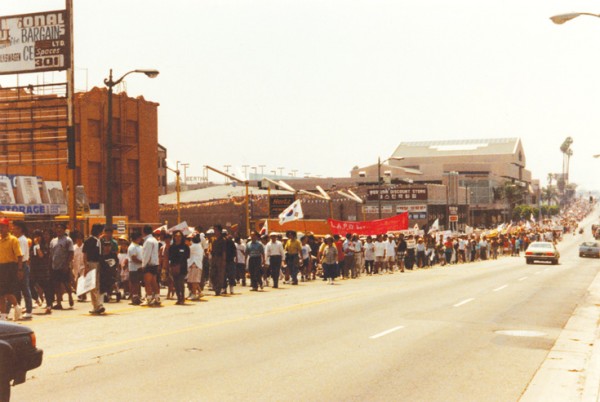April 29, 2012, marked twenty years after the LA riots.
It’s been said that the media coverage at that time played a part in worsening the violence. In an interview about his documentary, Clash of Colors: The LA Riots of 1992, David Kim describes that the media’s focus on the tension between the Korean American and African American community exacerbated the conflict. Twenty years later, most of mainstream media is still choosing to remember only the violent confrontation when it comes to the role of the Korean American community in the events of April 29, 1992.
Take for example, The Daily Beast’s article of the “9 Infamous Videos” of the LA riots. The only video they have that portrays the Korean American community is of them shooting at the looters. And the sucky thing is that we’re shown videos like these out of context. The caption kind of explains that that “the violence in Los Angeles had become so overwhelming that law enforcement was pulled out of select neighborhoods. Koreatown was one of the areas hardest hit by looting, so when the cops bailed, Korean store owners took matters into their own hands. ” But it doesn’t ask the important questions, like why did the LAPD decide that Koreatown was one of the “select neighborhoods” that they would bail out of? And plus, is this video really representative of how the Korean Americans were responding to the looting? This video (especially the guy in the white hat) makes it seem like they were just calming shooting anyone who walked by.
So when mainstream media fails us, community media like KoreAm comes in. Their April issue, In Our Own Words, was an oral history project that retraces the events of the LA riots. It gives us a sense of the panic at the time. Richard Choi, who was operating Radio Korea at the time, remembers a supermarket owner coming into his office with a gun in the morning of April 30th:
[Kee Whan Ha] said, “You keep telling people to flee, to go home, but how can we leave Koreatown? We came to this country and we worked like crazy and we made this town, our town. But if we leave, they’re going to burn it down. Don’t we have to protect our town? Can’t you say that on the radio?” And he offered to show us around so we could see what was going on. I couldn’t leave because I had to stay on the air, but Jang-hee Lee went out with Ha. And Lee came back and told Ha, “You’re right.”
Whether or not the shooting can be considered self-defense, or whether the Korean American community had the right to bear arms to protect their property in this case isn’t something I can say. But when we remember the events of the LA riots, we should listen to the personal experiences of those who lived through it, instead of by showing a 2-minute video clip of two people shooting. Sonny Kang, a college student at the time recounts:
“Radio Korea was the lifeline for people in the community. People could call Radio Korea if they felt like they were in danger. Calling 911 wasn’t going to do anything. Radio Korea would put it on the airwaves: “A beauty salon on Beverly and Vermont, the windows are getting smashed in … is there anybody that can help?” We’d drive there as fast as we can.”
If you keep reading the oral history compilation, you’ll find many more interesting accounts, for example of Korean American and African American communities helping each other out, of the peace march on May 2nd 1992, and of Roy Hong shedding light on how the white-dominated mainstream media pitted communities of color against each other to distract them from what actually triggered the civil unrest – the brutality of a white-dominated police force: “Every hour they were showing Rodney King getting beaten, cops being acquitted, and instantly they’d go to Soon Ja pulling the trigger on Latasha Harlins. If I was an African American youth, watching that shit, I would want to go beat up some Korean guy right now.”
[Photo credit: KoreAm]
- Excited
- Fascinated
- Amused
- Disgusted
- Sad
- Angry









